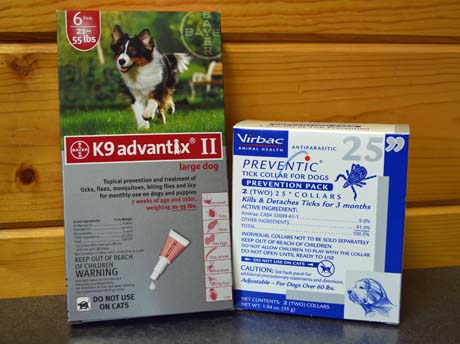Tick-borne diseases in dogs
Tick-borne diseases are a hot issue across the country. Recently, local, city and state-wide newspapers have published articles about the subject. Even The New York Times deemed the issue worthy and wrote an editorial about Lyme disease in people on Sunday, September 22.
But I particularly noticed a feature story in the current issue of Purina ProClub’s Update . More than any other source, this piece was clear and concise. In addition, an excellent chart (Common Tick-Borne Diseases in Dogs) was included that detailed disease name, tick carrier, pathogen and signs for each of the seven common, tick-borne diseases in dogs.
From that article, listed below are some interesting facts about ticks and tick-borne diseases that all dog-owners need to understand.
Tick facts.
• Tick populations are at an all-time high this year.
• Ticks don’t usually transmit disease until 24 to 48 hours after attachment.
• Ticks often transmit multiple diseases simultaneously.
Diagnosis is tricky and complicated.
• 50% or more of dogs living in Lyme disease endemic regions have positive titers (blood tests) but don’t show symptoms and so aren’t sick.
• Other tick-borne diseases can cause positive titers also but, again, the dog doesn’t show symptoms and so isn’t sick.
• The most common indicators of tick-borne disease are nonspecific, such as lethargy, decreased appetite and gastrointestinal signs.
• There is no perfect test* for tick-borne diseases. A veterinarian should use a combination of historical information, physical examination findings, laboratory tests and how well a dog responds to treatment.
Jerry and I are extremely pro-active about ticks throughout the year but especially during spring and fall when they seem to be most prevalent. We’ve cobbled together our own protocol.
1. We regularly monitor dogs for ticks, which isn’t difficult because they are easily noticed by petting and stroking.
2. After time in the woods or fields, we check for ticks. We use a narrow-toothed comb that works well.
3. We vaccinate puppies with LymeVax by Pfizer (requires two shots the first year) and then administer an annual booster.
4. During spring and fall, we apply the topical Canine Advantix II every three weeks. This repels and kills black-legged ticks (deer tick), brown dog ticks, American dog ticks and lone star ticks. Active ingredients are imidacloprid, permethrin and pyriproxyfen. It is waterproof but the dog must be dry for 24 hours both before and after application.
5. During spring and fall, we put on a Preventic Tick Collar by Virbac. This aids in the prevention of Lyme disease, Rocky Mountain spotted fever and babesiosis. Active ingredient is Amitraz. We have one serious precaution—don’t allow a dog to ingest the collar. It only took one time for Jerry and me to learn our lesson. We had two young dogs kenneled together and one chewed the tick collar off the other. All we found was the metal buckle. She became very ill but after induced vomiting and several worrisome days, she survived.
Seresto is a new tick collar from Bayer, introduced in January 2013. This collar slowly releases a chemical that stays on the coat of the dog for the eight-month protection period. Upon the recommendation of our vet, we didn’t try it. He was uncomfortable with the possibility of the chemical’s exposure to people through petting and handling. We’ll revisit this option as more information becomes available.
Even with all the monitoring Jerry and I do and the precautions we take, several of our dogs have become ill with a tick-borne disease. If we notice tell-tale symptoms, we consult with our vet and usually administer the antibiotic doxycycline for 28 days. For puppies, we use amoxicillin. Generally, the symptoms disappear within one or two days and the dog is on the mend.
* Dr. Linda Kidd, Western University of Health Sciences College of Veterinary Medicine in Pomona, California, is leading a one-year research project. Among other issues, her study will determine if comprehensive testing, i.e., using both tests (serology and PCR) instead of the current protocol wherein vets usually test one sample using one test. Another possibility is to test more than one sample.
The two tests are:
Serology detects the presence of antibody, which is one product of the body’s immune response against a pathogen.
PCR (Polymerase Chain Reaction) screening detects the nucleic acid, the DNA, of the organism itself.





